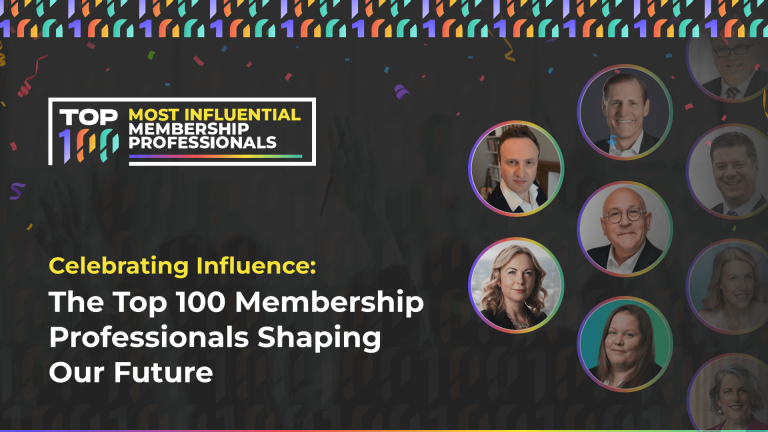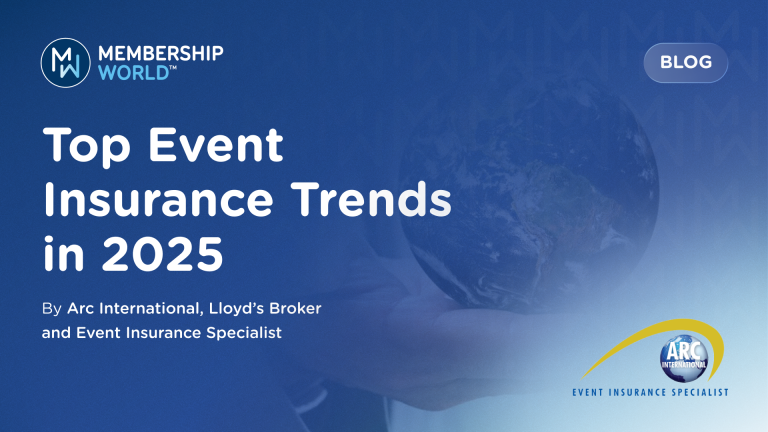
Business events have long been a key feature of association life. From annual conferences to smaller regional meetups, they offer invaluable opportunities to connect, share ideas, and reinforce organisational values. But in recent years, expectations have shifted. It’s no longer enough to run a polished programme and hope members show up and stay engaged. The events that make a lasting impression, and support member retention and growth, are those where engagement is actively designed into every stage.
Member engagement is not a buzzword. It’s a critical driver of value, trust and long-term loyalty. When associations get this right, business events become more than a calendar entry — they become spaces where members feel seen, involved and part of something that matters.
This blog outlines how membership leaders can use business events to build stronger connections, deliver tailored value and embed engagement into every interaction. It draws on sector best practice and Membership World insights to offer a comprehensive strategy for creating events that serve the people at the heart of your community.
Why Engagement Needs to Be a Strategic Priority
Engagement is often spoken about in general terms. But in practical terms, it means something very specific: members feel emotionally and professionally invested in the association, and demonstrate this through ongoing participation, contribution, and connection.
At business events, this engagement becomes visible; in who shows up, who contributes to conversations, and who continues the relationship after the event is over. A highly engaged event isn’t just one with high attendance. It’s one where:
- Members interact with each other and the content
- There’s evidence of peer support and exchange
- Participants follow up with further involvement
- The association captures insight to guide future strategy
When associations treat engagement as a strategic goal — rather than an accidental by-product — they begin to plan more effectively. This means setting objectives, defining what engagement looks like for different member types, and measuring success in ways that reflect more than numbers.
Understanding Member Expectations
To build engaging events, associations must first understand what members value. For most, the decision to attend a business event is a practical one. It involves time, travel, and often cost. Members weigh this against what they expect to gain.
Common expectations include:
- Access to relevant, actionable information that supports their role
- Opportunities to network meaningfully with peers
- A sense of inclusion and community
- Time well spent, without filler or unnecessary content
- Follow-up opportunities that extend the value of the event
Not every member wants to attend for the same reason. Some may be there to build professional skills, others to seek out collaboration, and others still to gain visibility in the sector. Your event design must account for this range of needs and make space for diverse forms of participation.
Gathering insights in advance — through registration forms, short surveys or informal conversations — can help tailor sessions to match expectations. The more personalised the experience, the more likely members are to engage fully.
Building Engagement Before the Event
Engagement begins well before the event day. In fact, the tone set in the lead-up period can determine how likely members are to actively participate. Associations that take a proactive approach to pre-event engagement tend to see stronger turnout, more prepared attendees, and higher satisfaction.
Practical strategies for building early engagement include:
- Segmented communication: Rather than blanket emails, tailor your messaging to reflect member roles, interests and previous involvement.
- Speaker previews: Short videos or interviews with speakers can create interest and offer early insight into content.
- Pre-event discussion groups: Use LinkedIn or member platforms to encourage early conversations on key themes.
- Early networking opportunities: Allow attendees to see who else is coming and suggest contacts based on shared interests.
- Member involvement in planning: Offer polls or voting on breakout themes or topics to increase buy-in.
This type of early involvement positions the event not as a top-down experience but as something co-created, and that mindset sets the tone for meaningful engagement throughout.
Delivering Engagement During the Event
Once the event is underway, engagement must be maintained through careful design and delivery. This is not about adding gimmicks or forcing participation, it’s about creating an environment where interaction is natural, supported and valued.
Here are ways to build in engagement at every touchpoint:
- Session formats: Include interactive sessions, peer-led panels, workshops and breakout discussions.
- Hosts and moderators: Equip facilitators to encourage contributions, manage energy in the room and adapt in real time.
- Engagement champions: Train volunteers or staff to support connections during breaks and identify disengaged participants.
- Technology: Use apps or digital platforms to share content, prompt questions and facilitate live polling or feedback.
- Variety of engagement types: Allow for group interaction, one-to-one conversations and quiet reflection.
Events should be accessible to different personality types and communication styles. While some members will thrive in discussion-heavy formats, others may prefer asynchronous or written contributions. A strong event creates multiple routes to involvement.
Designing Sessions for Value and Participation
The heart of your event lies in its sessions, and these should be carefully curated to support relevance and interactivity. Passive consumption of information rarely leads to lasting engagement. Instead, focus on participation-driven formats that allow members to explore ideas, solve problems and share experience.
Effective session planning involves:
- Clearly defined objectives: What should participants walk away knowing or doing?
- Diverse voices: Include speakers from different sectors, backgrounds and levels of experience.
- Practical outcomes: Offer tools, templates or processes that can be applied immediately.
- Structured interaction: Allow time for reflection, breakout discussions or peer response.
- Relevance to member roles: Ensure content maps to real-world challenges and responsibilities.
You can also invite members to lead sessions themselves. Peer-led case studies or panels can be powerful ways to showcase community expertise and increase ownership of the event experience.
Embedding Business Events Within Member Career Development
One of the most effective ways to maximise engagement is to position business events as key milestones in a member’s career journey. Members are more likely to attend, contribute to and advocate for events when they see them as helping them achieve tangible professional outcomes. This means aligning event content, structure and messaging with the different stages of career progression.
Associations can take the following approach:
- Early-career professionals benefit from foundational sessions that build skills, boost confidence and demystify sector standards. Networking formats should be supportive and structured to ease first-time interactions.
- Mid-career members are often looking to deepen their influence, explore leadership pathways and benchmark their work. Events can serve as platforms for them to share case studies, sit on panels or mentor newer members.
- Senior leaders and executives seek strategic insight, high-level peer exchange and direct input into sector development. Private forums, closed-door roundtables and speaker opportunities can help maintain their engagement.
Events should clearly communicate the value on offer for each career stage. Consider tagging sessions in the programme by level of experience or publishing tailored schedules to help members navigate options relevant to their goals.
In addition, use post-event engagement to map member interactions back to career development. For example, a member who leads a session might be invited to join a leadership mentoring scheme or contribute to an upcoming publication.
By framing business events as career touchpoints, not one-off engagements, associations reinforce their long-term relevance and help members see a direct connection between involvement and advancement.
Supporting Multigenerational and Inclusive Engagement
Today’s membership landscape spans multiple generations, each bringing different expectations, learning styles and communication preferences. Events that fail to account for this risk alienating part of their audience.
To build inclusive engagement:
- Offer content in varied formats — including visual, verbal and hands-on approaches.
- Schedule breaks and buffer time to avoid cognitive fatigue.
- Consider accessibility in all its forms — physical, digital, neurodivergent and linguistic.
- Use imagery and messaging that reflect the diversity of your membership.
- Avoid assumptions about digital literacy or professional experience.
Inclusivity also means acknowledging barriers that may prevent attendance or full participation. Hybrid delivery, scholarship places, childcare support or clear accessibility statements can help ensure more members feel welcome and valued.
Post-Event Strategy for Sustained Engagement
The period after an event is a golden opportunity for follow-up, and yet it’s one of the most underused stages of the event lifecycle. Members are still thinking about what they learned, who they met, and whether it was worth their time. The association’s next move matters.
Post-event engagement can include:
- Personalised thank-you messages with specific takeaways based on sessions attended
- Access to recordings, slides or summary notes ideally organised by theme or role relevance
- Invitations to continue conversations via working groups, online communities or webinars
- Content creation — inviting attendees to write blogs or share reflections
- Opportunities for contribution — such as joining a committee or helping shape future events
Use the insights gained during the event to segment and target follow-up activity. For example, someone who asked a question in a session on digital transformation might be invited to join a related advisory group. The goal is not just to close the event well — but to open a door to the next level of engagement.
Year-Round Event Engagement Strategy
Engagement shouldn’t be confined to the event window. A strategic approach sees business events as part of a wider year-round engagement framework, where each touchpoint builds on the last.
Ways to support this include:
- Building a calendar of regular, small-scale events (e.g. monthly drop-ins, themed roundtables)
- Creating resource hubs from past events (clips, toolkits, quotes)
- Scheduling follow-up sessions three to six months later to reflect on implementation
- Offering leadership pathways that link to event involvement
- Measuring ongoing activity (e.g. increased content engagement, community posts, volunteer uptake)
This approach helps members stay connected to the association, even between major events, and demonstrates an ongoing investment in their development and success.
Re-engaging Disconnected Members Through Events
Events can also serve as an effective strategy for re-engaging members who have become distant or inactive. Carefully designed outreach can reignite interest and demonstrate renewed relevance.
For these members, consider:
- Personalised invitations that acknowledge their history and suggest specific sessions
- Flexible registration options, such as day passes or on-demand content
- Reassurance that the event has changed or evolved
- Peer encouragement such as testimonials from similar members
- Opportunities to test engagement — e.g. attending a free pre-event webinar
These strategies show that the association understands their needs and is willing to meet them where they are.
Role of Staff and Volunteers in Member Engagement
Your team including staff, board members and volunteers, play a central role in shaping the member experience at events. Their visibility, approachability and tone all influence how members engage.
Make sure your team:
- Knows the event objectives and how to model engagement
- Is trained in welcoming, inclusive behaviours
- Has conversation starters or member insights to support interaction
- Is empowered to act on feedback and make real-time changes
- Understands how to help members connect with one another
When members see staff and leadership actively participating, they feel part of a vibrant, supportive community.
Using Events to Support Governance and Leadership Pipelines
Business events can be powerful moments to identify and nurture future leaders within your community. They offer a platform for members to share ideas, connect with decision-makers and test their interest in deeper involvement.
To make the most of this:
- Include sessions on association leadership or board pathways
- Invite committee members to share their experiences
- Offer informal spaces to express interest or learn more
- Publicly recognise member contributions
- Follow up with those who demonstrate initiative or alignment with governance needs
This ensures your leadership structures remain dynamic and inclusive, and helps members see a pathway to deeper involvement.
Business Events as a Core Membership Strategy
When aligned with your organisational goals, business events become much more than occasions. They function as:
- Member activation points — inviting participation from newer or passive members
- Brand amplifiers — showcasing your values, community and expertise
- Insight generators — surfacing new topics, gaps or emerging trends
- Relationship builders — deepening trust and loyalty across the network
By viewing events as core to your membership strategy, not separate from it, you can integrate them into everything from recruitment and onboarding to learning and advocacy.
Where Meaningful Events Begin
Maximising member engagement through business events is not about tactics. It’s about commitment to your members, your mission, and the quality of the experiences you create.
Every detail, from the initial email to the follow-up message, is an opportunity to demonstrate value and build trust. Associations that take this responsibility seriously don’t just run better events. They build stronger, more connected, and more resilient communities.
At Membership World, we support association professionals in shaping events that inspire action, connection and long-term impact. If you’re ready to strengthen your event strategy and deepen member engagement, join our growing global network today.



